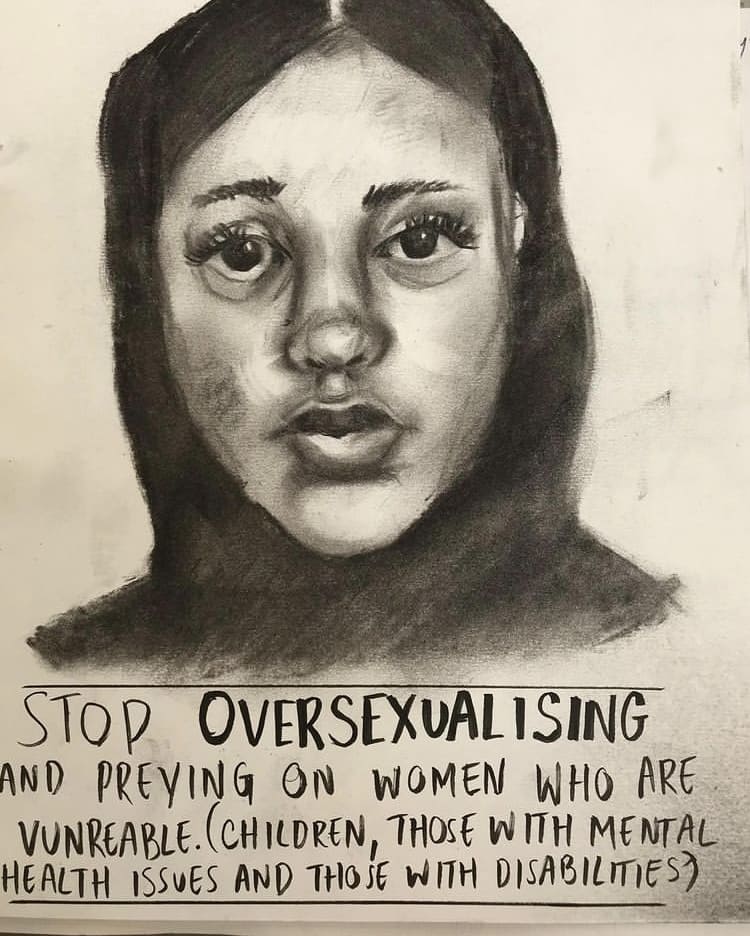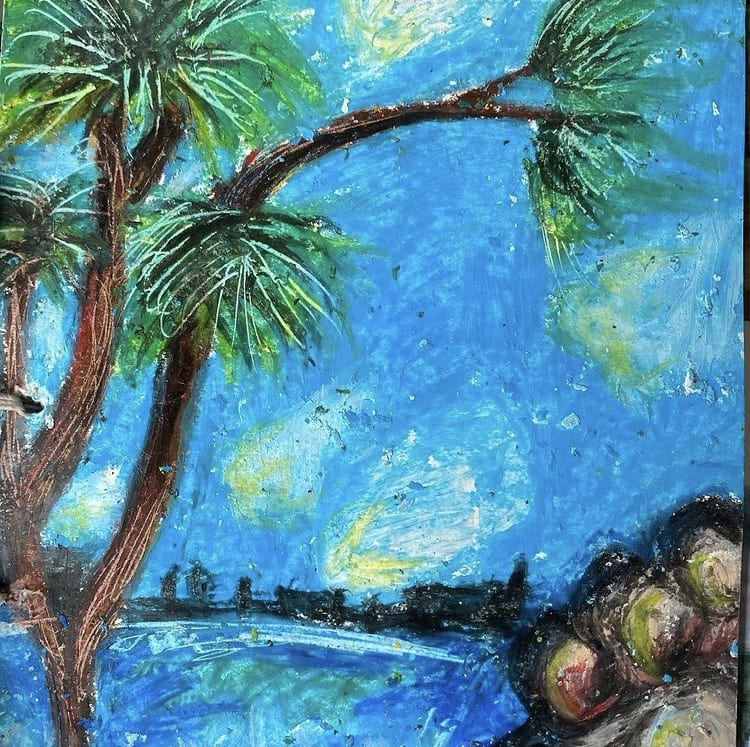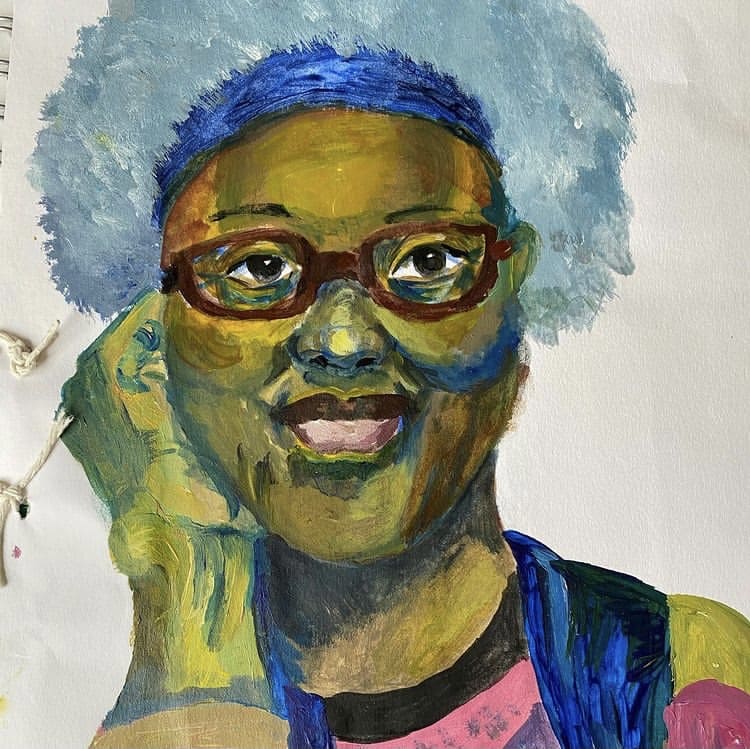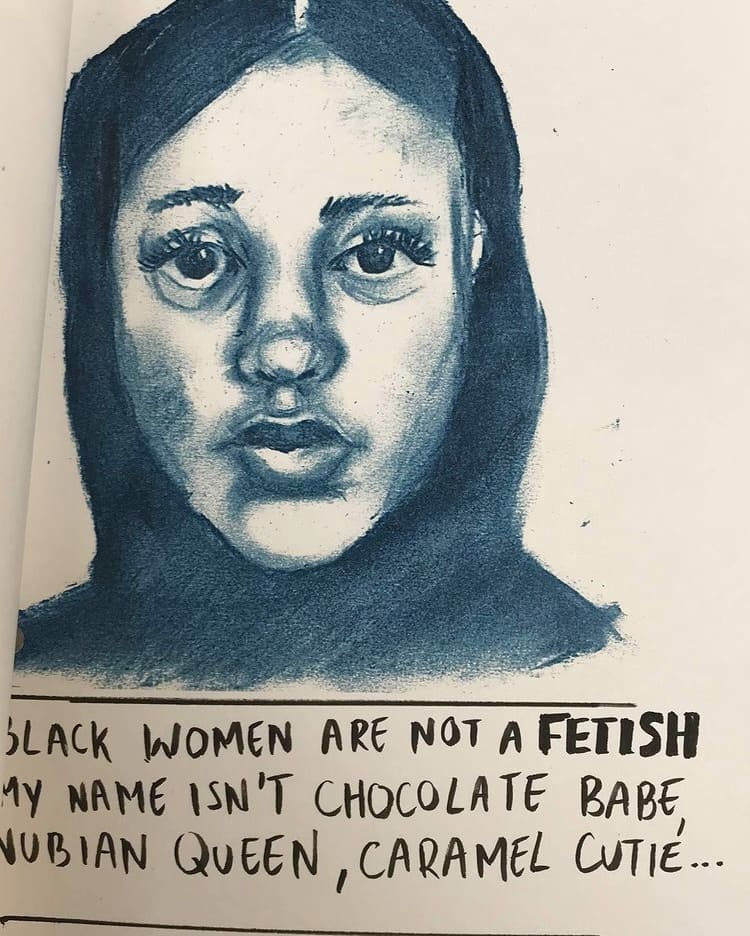Hannah Hall is an artist showcasing the ability to communicate social, cultural and political messages through her practice. Drawing from introspection and personal experiences, as well as delving into socio-political issues, focusing on intersectional feminism, and highlighting conversations around mental health and the fetishization of Black women, Hannah has established her practice as a form of creative therapy. Creating art that centres facial expressions as a way to narrative portraiture, whilst also utilising her words as a writer to enhance the outcome of her visual pieces. I spoke with Hannah to discuss her creative practice, influences, cultural referencing, the power of communicating with colour, her Monochrome series exhibited at the National Portrait Gallery, how she feels the art world can become more inclusive, and so much more.
NAHUEL CONTRERASWhat is your artistic background? HANNAH HALLMy artistic background evolved as a coping mechanism in strife; I would draw and paint as therapeutic needs. As I got older I became interested in socio-political art and colour as forms of expression. NCWho or what are your biggest influences? HHMy biggest influence is Marlene Dumas and Tatyana Fazlalizadeh; Dumas primarily for the abstract way of using ink and Fazlalizadeh for her moving street art. I also find stimuli from reading from poets like Rupi Kaur and feminist activists such as Florence Givens. NCThe painting “Head in the clouds” highlights your ability to conceptualise your ideas abstractly. How do you define your artistic style? HHI wouldn’t say my work fits into any particular box, however, I would describe it as emotive portraiture as a lot of my art evokes mental health discussions.
 NCYou are very experimental in your practice - a painting in the medium of watercolour, ink and acrylic; a drawing in the medium of graphite, charcoal and oil pastels; monoprints incorporating 3D wire; the utilisation of calligraphy and cotton wool. Are you able to elaborate on how these approaches enhance the narratives of your art, and impact your creative process?
HHI mainly create as a way of therapy. Using a variety of different materials means that I can have a sensory experience as I create. Different materials also add a different vibe; such as cotton wool implies a dream state so it allows me to explore surrealist art.
NCYour paintings utilise the visual impact of colour combinations to communicate. How important is the use of colour to your practice?
HHColour is very important as I use it to reflect mood. In my art works about ethnicity I use bright colour to show the happiness of exploring my Jamaican culture as well as bright hues to represent nostalgia. Things are often brighter in our minds, particularly as a child, which is when I remember my first visit to Jamaica.
NCYou are very experimental in your practice - a painting in the medium of watercolour, ink and acrylic; a drawing in the medium of graphite, charcoal and oil pastels; monoprints incorporating 3D wire; the utilisation of calligraphy and cotton wool. Are you able to elaborate on how these approaches enhance the narratives of your art, and impact your creative process?
HHI mainly create as a way of therapy. Using a variety of different materials means that I can have a sensory experience as I create. Different materials also add a different vibe; such as cotton wool implies a dream state so it allows me to explore surrealist art.
NCYour paintings utilise the visual impact of colour combinations to communicate. How important is the use of colour to your practice?
HHColour is very important as I use it to reflect mood. In my art works about ethnicity I use bright colour to show the happiness of exploring my Jamaican culture as well as bright hues to represent nostalgia. Things are often brighter in our minds, particularly as a child, which is when I remember my first visit to Jamaica. On the other hand, my work relating to more serious issues like mental health or feminism tend to be greyscale to represent a sadder mood. NCPerspectives within art are often shaped by cultural progressions throughout society. As Black artists, creating a perspective of visual resistance runs parallel to societal and systemic issues. Is your creative practice a way to explore and express your own identity, experiences and personal perception of socio-political issues? HHA lot of my work is based on my own life experience and also others that I know. My work is an attempt to bring light to issues like the fetishization of Black women, ableism and mental health, bringing them to the front of the conversation in a more explicit way, but also in an easier way to process like art and poetry.
 NCHas the intention of your art always been to inform political and cultural messages? How has your work evolved over time?
HHInitially my work was to create pretty pictures. In a time where I got unwell, I began using work to tell stories and making comics as a way of escapism. It then slowly turned into more political protest art; integrating my poetry to make a clear coherent message.
NCYour work is embedded in rich and meaningful cultural referencing. Could you elaborate on how family and cultural identity have greatly influenced the context of your paintings?
HHI would say the Jamaican environment is what inspired me. Seeing Jamaican street art and the colour palette. My family nurtured my love for art through funding me with some materials from a young age.
NCYou focus heavily on the human form; pose, composition and expression to incite dialogue. What is your approach to painting portraits and have you always gravitated towards figurative art?
HHI love looking at the intricacies of the human face, especially expression, and the impact of distorting a face, adding texture to the hair. Portraits allow me to explore in more elaborate ways than other forms of art have. I have always been interested in this form of art ever since I was a child.
NCCan you tell me more about your work that you exhibited in the Monochrome series at the National Portrait Gallery?
HHMy work looked at mental health as a series of events from different rooting; trauma and how it affects mental health and so on. I also drew famous portraiture within the gallery; fine-liner drawings on minted paper using a rubber to create highlights.
NCEmphasising on the lack of representation of diversity in cultural British society and the existing museum-industrial complex, what do you think the art world can do to become more inclusive?
HHI think we need to show more ethnic minorities in industries that lack it, more Black models, more Black artists and more Black people in areas of power. We need to tell messages in more explicit ways, show the truth and not be afraid of seeming controversial because we're talking about our Blackness or our struggles. We should do it in a way that makes people empathise such as in ‘Noughts and Crosses’, flipping situations. Showing how little regard there is for Black people and ethnic minorities in a very much Eurocentric world.
NCHow does intersectional feminism shape your artwork? How do you challenge, respond to and engage with societal and cultural narratives of women, and diverge from arts’ embedded patriarchal gaze?
HHI try not to conform to what is expected of art, naked women in alluring poses. I try to convey messages against what is expected of art. I like to shock people, inform and captivate people rather than creating things simply for aesthetics.
NCHas the intention of your art always been to inform political and cultural messages? How has your work evolved over time?
HHInitially my work was to create pretty pictures. In a time where I got unwell, I began using work to tell stories and making comics as a way of escapism. It then slowly turned into more political protest art; integrating my poetry to make a clear coherent message.
NCYour work is embedded in rich and meaningful cultural referencing. Could you elaborate on how family and cultural identity have greatly influenced the context of your paintings?
HHI would say the Jamaican environment is what inspired me. Seeing Jamaican street art and the colour palette. My family nurtured my love for art through funding me with some materials from a young age.
NCYou focus heavily on the human form; pose, composition and expression to incite dialogue. What is your approach to painting portraits and have you always gravitated towards figurative art?
HHI love looking at the intricacies of the human face, especially expression, and the impact of distorting a face, adding texture to the hair. Portraits allow me to explore in more elaborate ways than other forms of art have. I have always been interested in this form of art ever since I was a child.
NCCan you tell me more about your work that you exhibited in the Monochrome series at the National Portrait Gallery?
HHMy work looked at mental health as a series of events from different rooting; trauma and how it affects mental health and so on. I also drew famous portraiture within the gallery; fine-liner drawings on minted paper using a rubber to create highlights.
NCEmphasising on the lack of representation of diversity in cultural British society and the existing museum-industrial complex, what do you think the art world can do to become more inclusive?
HHI think we need to show more ethnic minorities in industries that lack it, more Black models, more Black artists and more Black people in areas of power. We need to tell messages in more explicit ways, show the truth and not be afraid of seeming controversial because we're talking about our Blackness or our struggles. We should do it in a way that makes people empathise such as in ‘Noughts and Crosses’, flipping situations. Showing how little regard there is for Black people and ethnic minorities in a very much Eurocentric world.
NCHow does intersectional feminism shape your artwork? How do you challenge, respond to and engage with societal and cultural narratives of women, and diverge from arts’ embedded patriarchal gaze?
HHI try not to conform to what is expected of art, naked women in alluring poses. I try to convey messages against what is expected of art. I like to shock people, inform and captivate people rather than creating things simply for aesthetics.
 NCSo much of art is the psychological relationship between the observer and the observed. As your work addresses larger social contexts, how do you balance between the eyes’ need to be visually stimulated, with expressing higher truths?
HHI try to add text to make the meaning very clear. Sometimes I don’t, explicit messages are not always needed. Sometimes it is better to allow people to have their own thought process, which in turn enhances the visual stimulation, and truth becomes subjective.
NCDuring the current socio-political climate, how have you been able to manifest inspiration and motivation?
HHI have found a lot of inspiration through the BLM protests and feminist vigils. Hearing people's stories allows me to use my art to expose exploitation of power through the patriarchy and systemic racism. Hearing people’s stories has also motivated me to create more protest art towards these issues.
NCAs a writer, how does your literary background and poetry influence your creative practice?
HHOften I create poetry first then draw after; my poetry is a stimulus for my drawings. My own poems inspire me to draw. Sometimes these will be small line drawings to big drawings, it all depends on if I think the message will be very impactful.
NCWhat is coming up next for you and your work?
HHThe future is like Fazlalizadeh; using my work in everyday settings, especially after the vigil I attend through OurStreetsNow; possibly using blown up pictures of my art on the street to tackle street harassment and posters in ethnic minority places to tackle racism.
NCSo much of art is the psychological relationship between the observer and the observed. As your work addresses larger social contexts, how do you balance between the eyes’ need to be visually stimulated, with expressing higher truths?
HHI try to add text to make the meaning very clear. Sometimes I don’t, explicit messages are not always needed. Sometimes it is better to allow people to have their own thought process, which in turn enhances the visual stimulation, and truth becomes subjective.
NCDuring the current socio-political climate, how have you been able to manifest inspiration and motivation?
HHI have found a lot of inspiration through the BLM protests and feminist vigils. Hearing people's stories allows me to use my art to expose exploitation of power through the patriarchy and systemic racism. Hearing people’s stories has also motivated me to create more protest art towards these issues.
NCAs a writer, how does your literary background and poetry influence your creative practice?
HHOften I create poetry first then draw after; my poetry is a stimulus for my drawings. My own poems inspire me to draw. Sometimes these will be small line drawings to big drawings, it all depends on if I think the message will be very impactful.
NCWhat is coming up next for you and your work?
HHThe future is like Fazlalizadeh; using my work in everyday settings, especially after the vigil I attend through OurStreetsNow; possibly using blown up pictures of my art on the street to tackle street harassment and posters in ethnic minority places to tackle racism. I would also like to learn more traditional skills such as perfecting oil painting and exploring digital art and animations to communicate with others.
